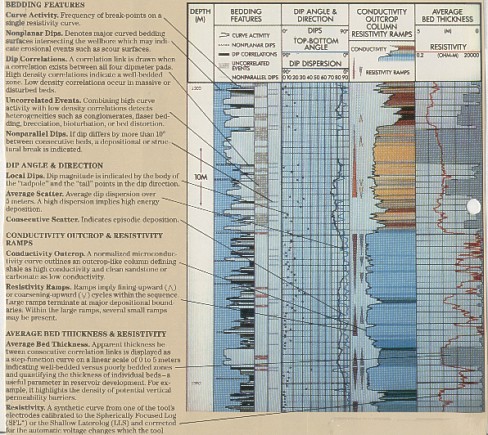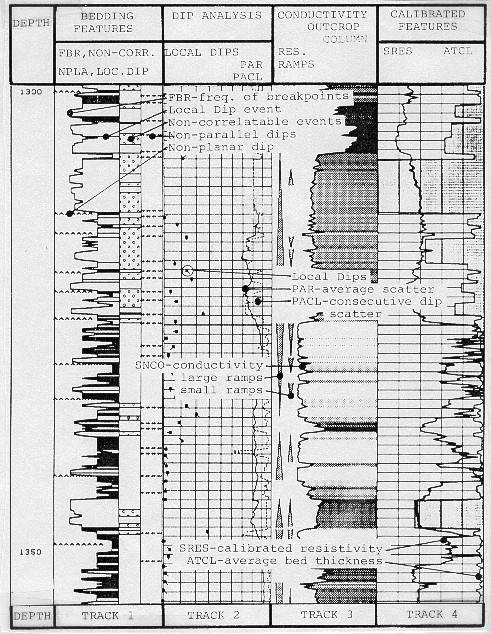|
 ADVANCED DIPMETER ANALYSIS USING
Synthetic Dipmeter Curves
ADVANCED DIPMETER ANALYSIS USING
Synthetic Dipmeter Curves
One of the problems associated with high resolution and stratigraphic
dipmeter results is the sheer volume of data. It is difficult
to review, let alone use, all the answers provided. Therefore
a systematic analysis procedure is as necessary here as it is
for other open hole logs. A computer program to facilitate this
procedure is available from Schlumberger, called SYNDIP. It is
presented here as an illustration of what can be done. You could
invent your own presentation to summarize your data set.
The
description below was extracted from “Uses of Dipmeter Synthetic
Curves” by Eric Standen, Trans CWLS, 1985.
SYNDIP
was developed to quantify and display synthetic curves calculated
from the dipmeter resistivity and computed dip data. This program
calculates up to seventeen variables, some of which are displayed
to present a geologic description of the formations in terms of
bedding and relative grain size information.
In
most cases, the Local Dip (pattern recognition) computation is
used for the necessary input dip data. If a Local Dip answer file
is not available, the Syndip program will still run; however,
some of the synthetic curves will be missing since they are computed
from Local Dip results.
The
program attempts to identify units of different bedding characteristics
and therefore different depositional environments. It also tries
to describe the overall sequence trends which would help in the
interpretation of the dipmeter. It does this by looking at things
that a human would look at, such as correlation curve activity,
resistivity trends, dip planarity, dip parallelism, dip scatter
(both magnitude and direction), and similar visually apparent
anomalies. These results are plotted as continuous curves or as
individual coded symbols.

Output plot for pattern recognition dip program SYNDIP

Output plot for pattern recognition dip program SYNDIP
The
frequency of curve breakpoints (FBR) is presented as a continuous
log curve and indicates the activity of one of the SHDT button
electrodes. A high frequency of breakpoints reflects a large number
of bedding planes. Typically, one would expect a high FBR in shales
and a low FBR in massive sandstones and carbonates. The opposite
can be true, however, if deep-water, non-bedded shales or cross
bedded sandstones and carbonates are present.
Each
correlation link from GEODIP or DUALDIP is displayed by a single
horizontal bar, superimposed on the FBR curve. If there is a high
density of correlations (DCL) then the zone is well bedded. If
it is low, then the zone is either massive or the bedding has
been disturbed such that correlations cannot be made across the
wellbore. Rough hole may be suspected and confirmed with a look
at the caliper curves.
In
the latter case, a comparison of the density of correlations with
the frequency of breakpoints should indicate a zone where FBR
is high and DCL is low. This situation will trigger a switch in
the Syndip program which prints out a "bubble" coding,
indicating non-correlatable interval. This coding can be interpreted
in different ways for different formations and may represent possible
bioturbation, brecciation, or distortion of bedding in the zone.
The
non-planarity flag is triggered when the Local Dip computation
falls below a preset planarity criterion. In general this reflects
curved bedding surfaces in the well bore which may indicate erosional
events or scour surfaces. The tolerance on this flag is set fairly
high so that only significant breaks are detected. Non-planarity
is shown as a jiggly line superimposed on the NBR curve.
The
non-parallelism flag is an indication that consecutive beds are
different in dip magnitude by ten degrees or more. The implication
is that there is some depositional or structural break, often
caused by cross bedding sequences. It is plotted as a short dashed
line beside the non-correlated interval bubbles.
All
of this information is plotted in the left hand track of the log.
Local dips are plotted in the next track along with two other
parameters, the average dip scatter (PAR) and consecutive dip
scatter (PACL).
The
average dip scatter (PAR) is actually the dip spherical standard
deviation on a polar plot of the dip data. Within a window of
length (usually five meters) an average dip magnitude variation
is computed and displayed on a reverse scale to the dip plot.
High dip scatter suggests a high energy of deposition as opposed
to a low dip magnitude scatter in low energy zones.
The
dip angle between consecutive correlation links (PACL) will track
with PAR but will usually show more variation since it is looking
at consecutive correlation links and not an average. PACL will
also reflect energy of deposition which can be analyzed for any
structural tilting of the formations. In track three, a normalized
micro-conductivity curve (SNCO) forms the outline for the outcrop-like
column and is derived from the button electrodes. The program
takes the resistivity values and scales them from 0 (high resistivity)
to 100 (low resistivity) taking into account the automatic voltage
changes that were applied to the tool during logging. The program
can also function and display the curve as an SHDT fast channel
conductivity, linear conductivity, or logarithmic resistivity.
The
colour or gray scale which is used to shade the curve area uses
light colours for high resistivity and dark colours for low resistivity.
These can be tuned to create a realistic image of the formation
layers. By inference, the presentation defines shales as being
low resistivity zones and clean sandstone and carbonate as high
resistivity. Should the opposite be the case, a switch in the
program will allow a reversal of the presentation.
In
addition to the outcrop presentation, fining upward and coarsening
upward trends are inferred from the resistivity curve values.
These are shown as large or small scale ramps beside the outcrop
curve. These cycles are derived from the SNCO curve and are simply
gradients on the curve which fall within certain parameters of
slope, maximum resistivity change, and minimum length. As with
the SNCO curve, the ramps can be reversed in the case of low resistivity
(relative to shale), coarse grained formations. The same logic
is used for short ramps as for the large ramps except that the
parameters are selected to limit the size of the small ramps.
Resistivity
ramps are used to estimate grain size variations. When the grain
size of the rock decreases, the volume of water (both irreducible
and bound to the clays) increases, with a corresponding decrease
in resistivity. The large ramps are designed to reflect large
scale features and should terminate at major depositional boundaries.
Within these large scale ramps several small ramps may be present
which may or may not agree with the major trend. This is a function
of the depositional environment. Likewise, the ramp trends of
Syndip may disagree with other information or log data such as
gamma ray logs. This situation does not indicate an error in the
program or any log; it is probably just a unique character of
that formation, for example a radioactive sand or variations in
amount of cementing or overgrowth.
In
track four is a calibrated, reconstructed resistivity curve (SRES)
and the average bed thickness curve (ATCL). SRES is calibrated
to an open hole spherically focused log or a shallow laterolog.
This curve has much finer resolution than the curve to which it
is calibrated.
The
apparent thickness between consecutive correlation links (ATCL)
is displayed on the log and is used as an indication of well bedded
versus poorly bedded zones. The curve can also be used to quantify
the thickness of the individual beds.
If
a zone is known to contain thin beds, procedures should be adopted
to increase the sample rate of certain logging tools or modify
the interpretation program for better thin bed resolution. For
reservoir development, knowledge that a zone contains thin laminations
may allow completion closer to a water leg since more vertical
permeability barriers exist. Conversely, a massive zone would
suggest higher vertical permeability.
The
analysis aids provided by the SYNDIP concept make it easier for
the analyst to sort out the structure and stratigraphy in a
well. The analyst is still stuck with the problem of choosing
which interpretation is most reasonable based on the available
data. A program which helps do this, the Dipmeter Advisor, is
discussed later in this Chapter.
|

